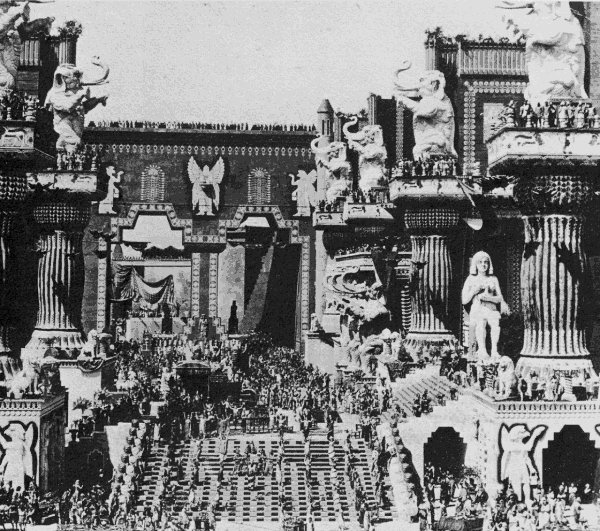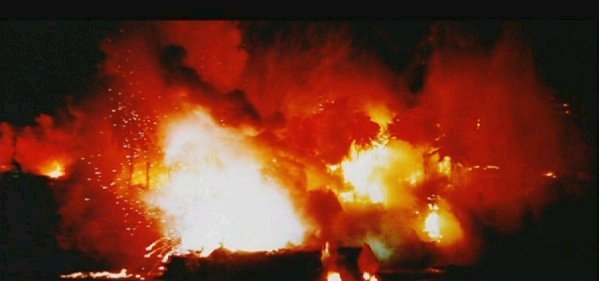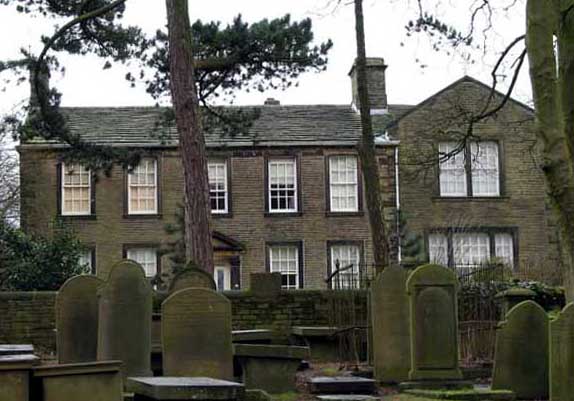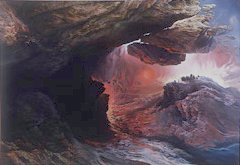His work continued to be an influence in the 20th and now 21st centuries. Early biblical cinema sets, such as those for D. W. Griffith's 'Birth of a Nation' were clearly modelled on the architecture imagined in Martin's works. The designs for 'Intolerance' visualised Jerusalem and Babylon from an engraving of 'Belshazzar's Feast' collated by Griffith's assistant Joseph Henabery.

The Fall of Babylon from Griffith's 1916 'Intolerance'
Later, director Francis Ford Coppola's 1979 epic film 'Apocalypse Now' was based on the Josef Conrad Book 'Heart of Darkness'. Perhaps Coppola was, in turn, inspired to create the horrendous yet sublime visions created by the Napalm attacks reflecting the sulphurous black, red and yellow hues of Martin's 'The Destruction of Sodom and Gomorrah' and 'The Great Day of His Wrath'.
The production was chaotic, troubled and well over budget. There were organisational snags, bad weather, unreliable actors and an actual civil war to contend with. However, it became and remains one of the top five films of all time.
'Lieutenant Willard' played by Martin Sheen (suffering at the time from alcoholism and a heart attack!) travels deep into the jungle to 'terminate with prejudice' Marlon Brando's insane 'Colonel Kurtz' who has 'gone native'. Although this is intrinsically a war film, it is also a journey into the darkest recesses of the human soul echoing the visions of both Conrad and Martin.

'Martinesque' Bombing Attack from Coppola's 1979 'Apocalypse Now'
In the excellent 'The Art of John Martin' by William Feaver, on cinematic influences he hypothesises that '... Historical reconstruction is a way to challenge time, and apocalypse comes as a fitting climax to any film epic; indeed, at one stage in the planning of 'Zabriskie Point' ... Antonioni asked Douglas Trumbull, his special effects expert, to explode the entire United States in a 'Great Day of his Wrath'. Sublimity, in cinematic terms, soars beyond time and space, over the lost horizon to Shangri-La and the intermingled past and future of '2001'. The First and Last Man, the traveller in Well's time machine, is now an astronaut.'
This is late 1960s America, as seen through the portrayal of two of its children: anthropology student Daria (who's helping a property developer build a village in the Los Angeles desert) and dropout Mark (who's wanted by the authorities for allegedly killing a policeman during a student riot).

'Poster Scene from Michaelangelo Antonioni's 1970' 'Zabriskie Point'
For the 2014 Christopher Nolan film 'Interstellar' the visual influence of Martin's apocalyptic paintings was acknowledged by physicist Kip Thorne and special effects adviser Paul Franklyn. This was discussed in the BBC Radio 4 programme 'Writing the Universe' 25/09/2025

_________________________________________________________________________________________________________________________________________________________________
One of the four short-listed artists for the 'Turner 2000' prize at Tate Britain was Hexham born Glenn Brown (b. 1966). His work reflects (to an extent of raising accusations of plagiarism) the work of others who he believes are deserving of greater recognition.
As with Martin, Glenn Brown's paintings are meticulous in their precision. He works on flat surfaces and emulates and hybridises the styles and works of artists such as Rembrandt, Salvador Dali, Van Gogh, Frank Auerbach and Willem de Kooning without producing 'fake' copies. Colours are highlighted and details manipulated but the genre does not result in a definable Glenn Brown trademark canvas.
Brown also mixes the styles of the earlier artists with those of today. In 'The Tragic Conversion of Salvador Dali (after John Martin) 1998' Brown interpolates Martin's 'The Great Day of His Wrath' with the work of the contemporary Science Fiction illustrator Chris Foss.
One of the best ways of gaining an insight into life in the first half of the 19th century is to visit the West Yorkshire village of Haworth near Keighley.
This is the location of the home of the Brontë literary family, The Brontë Parsonage Museum. The Brontë Society has preserved materials, room fixtures, fittings and display material to leave the visitor with a lasting experience of the period.
As well as a collection of Brontë sister's writing memorabilia, the problems of rampant disease, infant mortality, lack of adequate sewage disposal, alcoholism, the influence of the Church and finding work are highlighted. This family, as with the Martin's and other Victorian families, was brought up respecting the Bible's old testament. The children were in awe of the collection of John Martin mezzotints on display in their father Patrick's study. These influenced their lives and writing. 'The Deluge', 'Belshazzar's Feast' and 'Joshua Commanding the Sun to Stand Still' continue to be displayed in this room for you to see today.
Further information can be obtained from the Society's Web Site at Brontë Parsonage Museum, Haworth, Keithley, West Yorkshire BD22 8DR.

